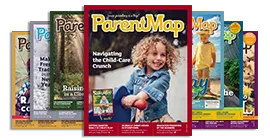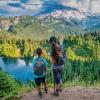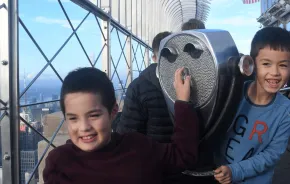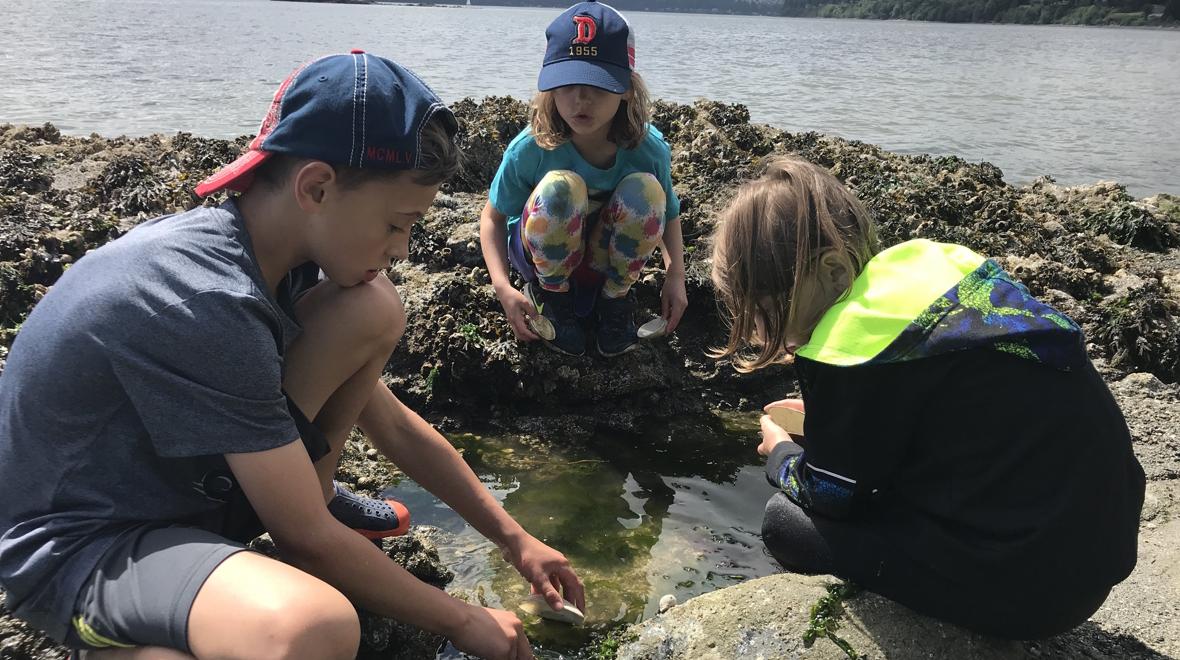
Photo:
Exploring tide pools. Photo: Kari Hanson
On a recent sunny afternoon, Vanessa Tippmann crouched down on the wet sand to show her 3-year-old daughter the difference between smooth emerald-green eel grass and bumpy Turkish towel, a reddish-brown algae.
The day before, they had spent three hours exploring the low tide at Edmonds’ Brackett’s Landing North and had enjoyed the experience so much that they returned for more.
“It feels like Christmas, finding all this fun stuff together,” says Tippmann, as the waters of Puget Sound lapped around her ankles. “All she has been talking about is natural stuff now, and it’s been educational for me, too.”
On days when the tide is especially low, Puget Sound’s beaches are filled with families experiencing the wonder of these hidden marine worlds. People of all ages are drawn to tide pools, which means adults and children can discover them together.
“We’re so lucky we have spaces where we can go and see these cool creatures that would normally be covered by the tide,” says Liz Hines, who leads Point Defiance Zoo & Aquarium’s Explore the Shore events. “You don’t need any experience other than the excitement to explore.”
What causes tide pools?
A variety of factors cause extremely low tides, including the gravitational pull of the moon. Tide pools result when the seawater retreats especially far from shore. When the tide recedes, the beach expands, revealing ocean life that is normally hidden below the waves. During these times, beachcombers can often find fascinating creatures in the small pools of water left behind in rocks, on the beach, or against old pier or dock pilings.

When to look for tide pools
While you can typically find seaweed and shells at any low tide, creatures such as moon snails, anemones, sea stars and even octopus may be spotted on days with a negative low tide. Negative, or minus, tides occur when the water level drops well below the average low-water levels. “You’re looking for anything -1.5 or greater,” Hines says. “Minus 2s and -3s are amazing.” On rare occasions, Puget Sound beaches may experience an extremely low tide of -4, which is the most exciting time for tide pool enthusiasts. Check online tide charts, such as NOAA’s, and locate your beach of choice during low tide. Time your visit at least an hour before the peak low tide to give yourself ample time to explore.
What to bring and wear
For rocky beaches, it’s best to wear sturdy water shoes or even rain boots. Since barnacles can scrape skin, cover up your feet if you’ll be climbing over rocks. Strollers can be tricky to navigate on the uneven terrain, so consider a hiking backpack or front carrier for infants. Young beach explorers might appreciate an extra set of dry clothes for warmth after the adventure. Pack a water bottle and snacks to fuel beach play afterward.
While some animals are easy to identify — such as sea stars and crabs — others might require a good guidebook. Check out the Point Defiance Zoo and Aquarium’s Field Guide or the Seattle Aquarium’s online guide. Phone apps such as iNaturalist can also be helpful.
Create a learning experience
During her time as a Seattle Aquarium beach naturalist, Dawn Chesbro enjoyed engaging young beachgoers on the low-tide walks. She would find an old crab shell and ask young onlookers: “Do you think this crab is alive or dead?” The answer, of course, is that we don’t know. The crab molts and leaves behind its old shell.
Questions like that can help prompt curiosity and interest among young tide pool enthusiasts. As a parent, you can also encourage your child to consider why a creature behaves a certain way. For example, why do crabs scuttle away so quickly when you pick up a rock? Why do sea stars frequent rocky crevices and pier pilings?
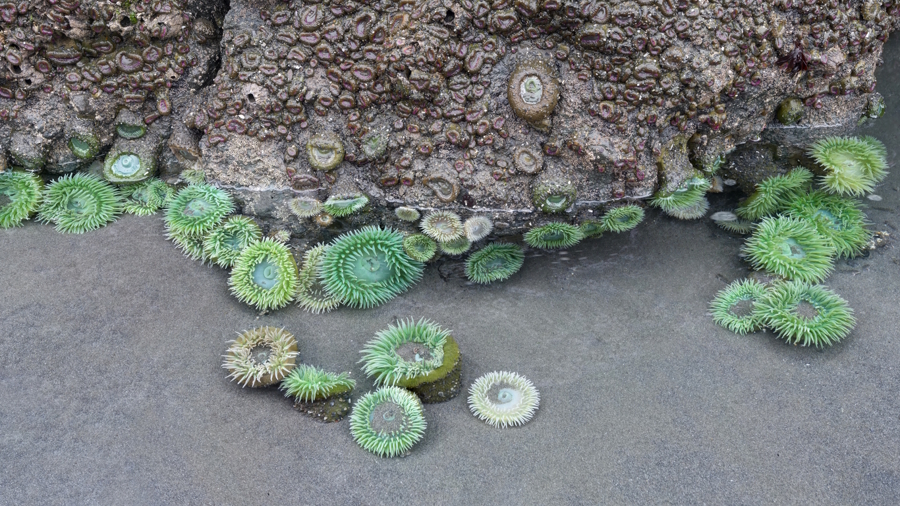
Be mindful of tide pool etiquette and safety
When searching for sea creatures, keep in mind you’re a guest in the animals’ homes. Chesbro would often remind children that they wouldn’t want a friend to come over and mess up their home. Similarly, you want to be a respectful — and gentle — visitor in the sea creatures’ world. A magnifying glass or phone camera can help young beachgoers zoom in on an animal’s intricacies without picking the creature up. Algae and seaweed can be slippery, so be mindful where you’re walking. Keep an eye out for the returning tide and start moving closer to the shoreline when you see it coming in.
Identifying tide pool wonders
Even everyday low tides can reveal sea treasures, such as clam or scallop shells and various types of seaweed. It’s also common to spot small sea snails or tiny shore crabs on rocky beaches, including some that are no more than the size of a nickel. During super low tides, you are more likely to find sea stars, ranging from the thick ochre stars to the slender Pacific blood star. Other animals are even more elusive, like the otherworldly sea slugs, or nudibranchs. (Among the local favorites are the shaggy mouse, sea clown and opalescent.) The best advice for finding those harder-to-spot creatures: Take your time, Hines advises. “Take a moment and observe what’s right at your feet. Look in the kelp and seagrass. Observe your surroundings and be in the moment.”
It’s about more than tide pools
While spotting cool animals is engaging and fun, the benefits of exploring tide pools extends beyond species identification, says Chesbro. Examining tide pools can instill a sense of wonder and appreciation for the broader environment. “For many kids, this is their first introduction to the Puget Sound: coming down and looking at tidepools at the beach,” she says.
That excitement was evident on the recent low-tide day at Edmonds’ Brackett’s Landing as Christie Verda held her 2-year-old son while her 4-year-old daughter searched for sea stars under the ferry dock. “This gets us out of the house and in the fresh air,” she said, pausing as she spotted a seal popping up alongside the Edmonds-Kingston ferry.
Check out these prime tide pool spots around Puget Sound
North Puget Sound: Brackett’s Landing North Park in Edmonds, Richmond Beach Saltwater Park in Shoreline, Carkeek Park in North Seattle
Seattle: Golden Gardens Park, Olympic Sculpture Park Pocket Beach, Discovery Park, Constellation Park
South Puget Sound: Owen Beach in Tacoma, Titlow Park beach in Tacoma, Dash Point State Park in Federal Way
Road trip destinations: Double Bluff Beach on Whidbey Island, the Olympic National Park’s Ruby Beach and Oregon’s Cannon Beach

Guided naturalist events
Point Defiance Zoo & Aquarium will offer several free Explore the Shore events, during which participants can investigate the shore at low tide with naturalists. Check out the Explore the Shore page for more information and upcoming summer dates.
Seattle Aquarium’s seasonal Beach Naturalist program has been confirmed for 2025. Participants can explore 10 different Seattle-area beaches at low tide, guided by volunteer naturalists. More information can be found on the aquarium’s Beach Naturalist page.
Upcoming negative low tides
Mark your calendar for the upcoming extremely low tides in Puget Sound. Check your local tide charts for more precise figures and times.
- June 11–14
- June 23–28
- July 10–13
- July 21–26
More family-fun at Puget Sound beaches: |


